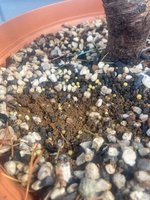There are three grades of Akadama…. I use double or triple line types except for deciduous and water loving trees. It can be somewhat ‘wrought with danger’ when a hobbyist just asks for akadama. Understanding different brands can be a minefield as manufacturers change.
Here’s some info on each:
Depending on the quality of the Akadama bonsai soil (soft and hard) it should be replaced after 3-5 years. (This is a generalization ed note)
Akadama soft quality, Single line brand: Japanese 上質, Jōshitsu. Structural stability for up to 3 years. Can be used for
bonsai trees that are frequently repotted (deciduous trees with strong root growth like
Fig tree bonsai,
Chinese elm bonsai,
Japanese maple bonsai, but also other plants such as flowers).
Akadama hard quality, Double line brand: Japanese 硬質, Kōshitsu. Is structurally stable for longer time (4-5 years). Akadama hard quality should be taken if the bonsai remains longer than 3 years without repotting in the
bonsai pots. This is especially true for older bonsai.
Akadama extra hard quality, Triple line Brand: Japanese 赤玉土. The Akadama brand with the 3 lines is broken down from slightly deeper layers, heated at 250-300°C after processing and is therefore the longest structurally stable kind of Akadama.
- DSD note when recycling Akadama media I use 450F… kind of a compromise between double and triple line. It retains the integrity of the particles without getting Uber hard.
Cheers
DSD sends





